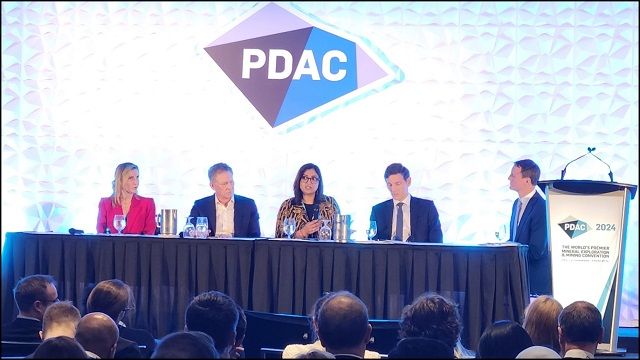The panel discussion on the future of commodities in volatile markets, specifically focused on critical metals in the context of the energy transition, covered several main topics that are important to the industry’s adaptation and growth.
The panel, moderated by Colin Hamilton (Managing Director, Commodities Research, BMO Capital Markets), included Jonathan Price (President and CEO, Teck), Kent Masters (Chairman, President and CEO, Albemarle), Deshnee Naidoo (CEO, Vale Base Metals), and Sonia Scarselli (Vice President, Metals Exploration & Xplor, BHP), and discussed the complexities and opportunities that lie ahead for the metals industry, particularly in the context of the energy transition.
The key topics discussed were:
- Sustainability as a Competitive Advantage:
- The panelists discussed how sustainability is no longer just a regulatory requirement but a strategic advantage that can differentiate companies in the market.
- This involves responsible extraction and processing practices that minimize environmental impact and ensure the well-being of local communities.
- Balancing Growth with Sustainability:
- With the rapid growth of the industry driven by the demand for critical metals for green technologies, finding a balance between expanding operations and maintaining sustainable practices is crucial.
- The discussion highlighted the importance of long-term planning and investment in sustainable technologies to manage growth responsibly.
- Community Engagement and Social Responsibility:
- The importance of engaging with local communities and ensuring that the benefits of mining activities are equitably distributed was a significant focus.
- This includes proactive environmental preservation efforts, local business engagement, and transparent communication to build trust and support continuous operations.
- Technological Innovation in Exploration and Operations:
- Panelists emphasized the role of new technologies, such as artificial intelligence and machine learning, in accelerating the discovery of critical minerals and improving the efficiency and sustainability of mining operations.
- The adoption of technology can also reduce the environmental footprint of exploration activities and enhance the precision of operations.
- Challenges of Market Volatility:
- The discussion addressed the challenges posed by market volatility, including fluctuating prices and demand.
- Strategies for managing these challenges include long-term planning, diversification of supply sources, and investment in technologies that can adapt to changing market conditions.
- Supply Chain Security and Ethical Sourcing:
- The panel touched on the increasing importance of secure and ethically sourced supply chains.
- This includes ensuring the traceability of materials, meeting the sustainability demands of end-users (such as OEM carmakers), and adhering to international standards and certifications.
- Regulatory and Permitting Challenges:
- The difficulties associated with obtaining permits and navigating regulatory frameworks, especially in the context of expanding operations to meet demand, were discussed.
- Strategies for overcoming these challenges include early and ongoing engagement with local communities, governments, and other stakeholders.
- Investment in Sustainable Practices and Technologies:
- The need for significant investment in sustainable practices and technologies to meet the future demand for critical metals was a key point.
- This includes funding for research and development in new mining and processing technologies that are less impactful on the environment.
- The Role of Collaboration and Partnerships:
- Finally, the panelists highlighted the importance of collaboration and partnerships among mining companies, governments, local communities, and end-users to address the complex challenges of supplying critical metals for the energy transition.
- This collaborative approach is essential for aligning interests, sharing risks, and ensuring the long-term sustainability of the industry.
PHOTO 1: CEO Panel on Critical Metals

Permitting Challenges
Jonathan Price highlighted that one of the significant hurdles in bringing new mining projects online is the complex and time-consuming permitting process.
He pointed out, “Yes, there’s been a lack of exploration, across the industry over the years so we don’t have projects from a technical perspective that are ready to go and that even when we do, permitting is really an issue.”
This fact underscores the gap between the demand for critical metals and the industry’s capacity to expedite new projects under current regulatory frameworks.
Balancing Growth and Sustainability
Kent Masters emphasized the challenges of managing growth in a volatile market, noting, “We have these demand drivers of a 20 to 30% growth rate that we’re trying to keep up with and build capacity at the same time as prices come crashing down. So it is a challenge.”
Masters’ insights reveal the delicate balance companies must strike between expanding capacity to meet surging demand and maintaining financial stability.
Moreover, his emphasis on sustainability as part of the value proposition underscores the increasing pressure from end-users, particularly OEM carmakers, for responsible and ethical sourcing of materials.
The Role of Proactive Environmental Preservation and Community Engagement
Deshnee Naidoo focused on the critical role of proactive environmental preservation and community engagement, asserting, “What does that give us as an industry? It gives us continuity of operations. And continuous operations mean a positive cash impact.”
Naidoo’s perspective highlights the interconnectedness of environmental stewardship, social responsibility, and economic viability.
Engaging with local communities and minimizing environmental impact are not just ethical imperatives but also strategic investments in the future stability and profitability of mining operations.
Accelerating Discovery Through Technology
Sonia Scarselli emphasized the potential of technology to revolutionize the exploration process, stating, “We can be more precise on our activity, we can accelerate the work, and be faster to discovery.”
Scarselli’s comments point to the transformative impact of artificial intelligence (AI), machine learning (ML), and other technological innovations on the mining industry.
By leveraging these tools, mining and exploration companies can expedite the discovery of critical minerals, reduce environmental footprints, and ultimately, enhance the efficiency and sustainability of their operations.
Final Thoughts
The panel discussion shed light on the challenges and opportunities facing the commodities market in the era of the energy transition.
The insights from the panel underscore a collective recognition of the need for sustainable practices, community engagement, technological innovation, and strategic collaboration to meet the growing demand for critical metals.
As the industry navigates volatile markets and complex global supply chains, these principles will be important in ensuring the resilient and responsible supply of the metals essential for a green future.
Notes: All numbers in CAD unless otherwise stated. The author of this report, and employees, consultants, and family of eResearch may own stock positions in companies mentioned in this article and may have been paid by a company mentioned in the article or research report. eResearch offers no representations or warranties that any of the information contained in this article is accurate or complete. Articles on eresearch.com are provided for general informational purposes only and do not constitute financial, investment, tax, legal, or accounting advice nor does it constitute an offer or solicitation to buy or sell any securities referred to. Individual circumstances and current events are critical to sound investment planning; anyone wishing to act on this information should consult with a financial advisor. The article may contain “forward-looking statements” within the meaning of applicable securities legislation. Forward-looking statements are based on the opinions and assumptions of the Company’s management as of the date made. They are inherently susceptible to uncertainty and other factors that could cause actual events/results to differ materially from these forward-looking statements. Additional risks and uncertainties, including those that the Company does not know about now or that it currently deems immaterial, may also adversely affect the Company’s business or any investment therein. Any projections given are principally intended for use as objectives and are not intended, and should not be taken, as assurances that the projected results will be obtained by the Company. The assumptions used may not prove to be accurate and a potential decline in the Company’s financial condition or results of operations may negatively impact the value of its securities. Please read eResearch’s full disclaimer.




